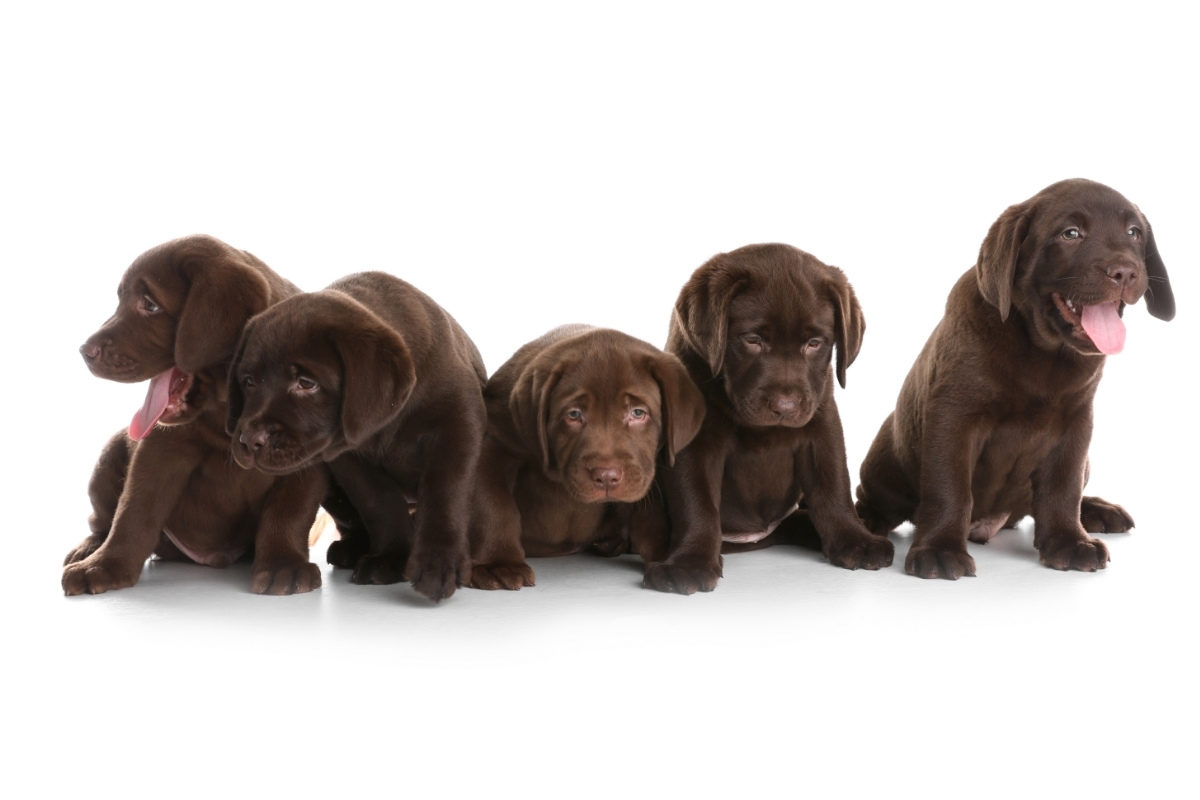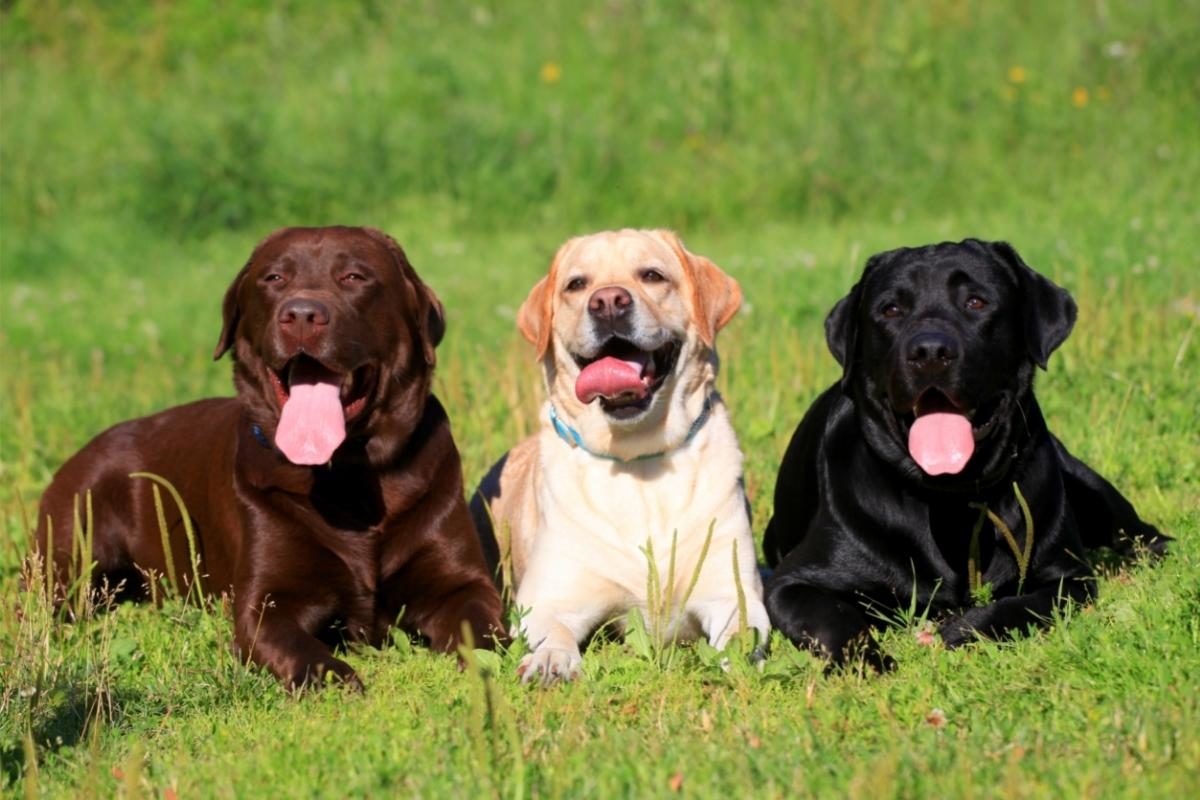Labrador Retrievers are the most popular dog breed, so they are the epitome of what a dog should be for many people. But what is it like living with one? Is there anything bad about them? And are they a good choice for first-time owners?
Labradors are excellent dogs for first-time owners as they are friendly, good-natured, easy to train, and good with children and other pets. They are also intelligent, loyal, devoted, socialize well, and are fun to be around. However, they do need lots of exercise and shed a lot.
To understand whether a Labrador Retriever would be a good first dog for you, we’ll explore the characteristics and personality, good and bad, of the Labrador. The Lab’s traits must fit your situation to avoid a mismatch and the dog sadly having to be re-homed.

So, let’s investigate if the Labrador is a good dog for you as a first-time owner.
Are Labradors Good for First Time Owners?
The traits and personality of the Labrador are essential things to consider when you’re deciding if the Lab will be a good first dog for you.
Remember that not all of these characteristics will be considered favorable to everyone. However, they will allow you to understand what you should expect when you get a Labrador Retriever and determine whether or not you think you can handle a Lab as a first-time owner.
Okay, so let’s get right into the things to know.
1. Labradors Are Easy To Train
You’ll be pleased to know that the Labrador is considered highly intelligent and thus easy to train. They are eager to please and love having a job to do. You only need to look at the Lab’s history – they were intentionally bred as working dogs.
Historically, the Labrador Retriever earned his keep as a fisherman’s helper by retrieving fish and fetching ropes from the North Atlantic Sea in Newfoundland, Canada. This was a skill that required not only intelligence but concentration, decision-making, and stamina.
Having been brought to England by fishermen in the early 1800s and further refined, modern Labs are still as good-tempered and hardworking as their predecessors.
They can be trained to perform almost any task and often work as retrievers for duck hunters, assistance dogs, drug detection dogs, and search and rescue dogs.
As long as you’re willing to remain consistent with your training and reinforce good behavior, training your dog won’t be too difficult of a task and is one of the main attractions why Labs are good for first-time owners. As they are very highly food motivated, training becomes extra easy.
You should start socialization and training when you bring your puppy home, usually around the 8-week mark. You can take some Labrador puppy training insights from my guide, 7 Speedy Ways To Train a Labrador Puppy.

2. Labs Are Extremely Friendly
Labradors are good-tempered, friendly, highly social, and love interacting with people, dogs, and other pets, making them ideal for first-time owners. They are great for families but also do well with a sole owner.
Due to their kind temperament, they will shower the whole family with affection. They are pleasant and gentle with children and babies but as with any pet, be sure to supervise your dog at all times. Due to their easy-going nature, they are more tolerant of children’s behavior than some other breeds.
Related: How to Read Labrador Body Language: 24 Signs Decoded.
Labs are also dog-friendly and tend to enjoy playing with other dogs. Of course, they need to be socialized as a puppy first, as this is how they learn to behave appropriately with other animals and people.
They will also tolerate other pets, such as cats, mainly if they have grown up with them. This is due to Labradors having a relatively low prey drive. Most have no desire to hunt and chase other animals, such as squirrels or birds. They were bred to accompany their owner in retrieving the killed prey after flushing them out.
Therefore, it is no surprise that Labradors are a popular choice for families as a good first dog.
Learn More About The Labrador In Our YouTube Video…
3. Labradors Shed – A Lot!
The Labrador has a thick, water-resistant double coat that molts – a lot! You’ll have to brush at least 2-3 times a week when you own this breed.
In addition to shedding year-round, they also “blow their coat” twice a year in the fall and spring. That means you’ll have daily brushing when your dog’s undercoat begins to shed while making way for his new coat to come through. Check out this article for more info on Labrador Shedding: Do Labs Shed? Season and Solutions.
On a positive note, Labs are easy to groom as their short, smooth coat is easy to care for. They only need to be bathed every 2-3 months or if they get extra muddy or smelly!
However, you may want to consider a Labradoodle if you’re looking for a less shedding breed.
4. Labradors Love To Eat – Watch Out For Obesity!
The correct nutrition is especially significant for this breed as Labradors are prone to obesity – they love to eat and love treats! But why?
Scientists have found that a variant of the POMC gene, strongly associated with weight and appetite, is prevalent in obesity-prone dogs. The mutated gene is known to regulate hunger and food motivation. This may explain why Labs may always be hungry!
Therefore, keeping an eye on your Labrador’s weight is crucial to his health and longevity. Not only do they need high-quality food, but also the right balance of calories, protein, minerals, and vitamins.
Experts also recommend that Labrador puppies eat dog food specially formulated for large breeds. These ensure that the puppy grows at the correct rate and not too quickly. This can help prevent joint diseases as they develop.
These foods include more protein, lower amounts of calcium, phosphorus, fat, and the correct amount of fatty acids, vitamins, and minerals. Large-breed dog food is also essential when your Lab is an adult.
To help you with all of this, here’s my complete guide on the best diet for Labradors, including nutrition, types of food, and exactly what they can and can’t eat.
You should feed an adult Labrador two portions of high-quality pet food a day instead of one big meal. This helps prevent bloat (Gastric Dilatation-Volvulus), which can be life-threatening if not treated quickly.
Always follow the recommended amount on your dog’s food packaging and keep treats to a minimum. I recommend feeding fruits as food rewards for your Lab.

5. Labs Love Water
Labradors love water – any water, whether it be a pond, lake, river, ocean, or a muddy puddle to lie in to cool down! So, why is this?
Labrador Retrievers are direct descendants of the extinct breed known as the St. John’s Water Dog from Newfoundland – so it’s in their DNA! They were known as water dogs due to their love of the water when helping the fishermen. They were powerful and tireless swimmers who could tolerate the coldest water for long periods.
The St John’s Water Dog (also known as the Lesser Newfoundland) was exported to England and then bred with British hunting dogs to create the Labrador.
They became good duck-hunting dogs working quietly alongside hunters. As the birds fell from the sky, they used their excellent noses to find and retrieve dead or wounded birds, making them the king of waterfowl retrievers.
The Labrador’s waterproof coat is especially suited to swimming, and their thick, narrowing “otter tail” tail is quite broad and strong, acting as a rudder. Their webbed toes also make them excellent swimmers.
6. Labradors Are Hopeless Guard Dogs
Most Labs are happy to see everyone – including strangers! They’ll bark when someone comes to the door, but they’re not overly protective.
They are a friendly, trusting breed and are more likely to lick an intruder to death! If an intruder has some food, they’ll probably show him where the safe is!
Good guarding breeds tend to be those initially bred to protect livestock, whereas the Lab’s job was to retrieve. They did not need to show aggression, hence their low aggressiveness and high level of friendliness.
However, Labs can make good watchdogs if they’re correctly trained to alert you of any threat by barking, but most are unlikely to engage in the threat.
So if you are looking for a guard dog, this breed is not for you, and you may be more suited to the mighty German Shepherd.

7. Labs Can Live an Average of 12 Years
When it comes to your first dog, you want a breed that’ll live a long and happy life without any major health issues. As long as you properly exercise and feed your Labrador, you’re looking at an average lifespan of around 12 years!
Of course, many dogs will live longer than this, especially if you’ve cared for them really well. This study showed that 89.7% of a cohort of 39 Labradors that maintained lean body mass and reduced accumulation of body fat lived to either meet or exceed the typical life span.
Another long study of 48 dogs evaluated from puppyhood over two decades showed the importance of keeping your Lab in a lean body condition. The average life span of lean-fed dogs was extended by an average of 1.8 years (15%)!
It was also discovered that maintaining optimal body health can delay the onset – and reduce the severity of osteoarthritis. Other chronic and age-related diseases were also delayed.
So, what’s the bottom line?
Looking after your dog and feeding him the correct diet will give him a better chance of living a longer and healthier life.
8. Labs Are Prone to Hip and Elbow Dysplasia
Overall, Labradors are relatively healthy and long-lived dogs, with a lifespan of around 10-12 years, although they have an increased risk of developing hip and elbow dysplasia.
This is a painful hereditary condition of the hip due to the ball and socket joint being too loose or not developing correctly. It can lead to lasting osteoarthritis, negatively impacting the health and welfare of the dog.
Certain types of exercise, too much or even too little exercise, improper nutrition, and obesity can aggravate this genetic condition, so it’s imperative to care for your Lab correctly.
In the first instance, you can reduce the risk by finding a responsible breeder and choosing a puppy whose parents have been screened for hip dysplasia and therefore have healthy hips.
Screening is a proven concept. This UK study demonstrated that participation in screening schemes improved genetic trends concerning hip score and elbow grade. Six purebred breeds participated, one of which was the Labrador Retriever.
There are various schemes to assess hip traits. These help breeders determine the condition of their dog’s hips. The Orthopedic Foundation for Animals (OFA) health testing aims to reduce genetic diseases. A similar scheme operating in the UK is the British Veterinary Association hip dysplasia scheme.
The latest statistics from the OFA show that 11.7% of Labradors are prone to developing hip dysplasia and 10.0% elbow dysplasia. When choosing my breeder, one of the first things I checked was the parent’s hip scores – and that they were both Kennel Club registered.
There are some treatment options to reduce the symptoms in less severe cases of hip dysplasia. These include joint supplements and anti-inflammatories.
It’s also essential to ensure your Labrador has a good bed. They need an orthopedic bed suited explicitly for large breeds that provide extra support for their joints. This is especially important from puppyhood as your dog may not develop arthritis or joint issues until he is much older.

9. Labradors Are So Clingy!
You desperately want to spend time with your dog right now, but the Labrador often takes it to the extreme, and they can become quite clingy, even following you to the bathroom!
This study also found that Labradors are getting needier. This is due to unnatural breeding by breeders wanting to create more loving and affectionate pets.
During the study, researchers conducted a feeding experiment to compare the behavior of three breeds, Labradors, German Shepherds, and Czechoslovakian Wolf-dogs, to find out which breed primarily relied on humans.
Labs were the most likely of the three to look to their owner for support and reassurance through “human-directed gazing” associated with neediness and dependency.
Owners are often also to blame for this needy behavior and may inadvertently cause it, especially if they are constantly petting, cuddling, and complimenting their Labrador!
Another consideration is that Labradors don’t like to spend long periods alone and may suffer from separation anxiety. I never leave my dog alone for longer than 3-4 hours, and I always make sure to exercise her well beforehand.
If you are out at work all day, don’t worry, as there are many things you can do to ensure your Lab is correctly cared for. Check out my guilt-free guide on How Long Can Labradors Be Left Alone? for some much-needed insight.
10. Labs Are Energetic & Fun – Lots of Exercise Required!
Labradors are the perfect fit for anyone with an active lifestyle who likes to take their dog with them on their adventures! Adult Labs require a ton of exercise, a minimum of 1-2 hours per day, to get rid of their pent-up energy and prevent behavioral problems.
Exercise should include walking and off-leash running in a safe area. Activities should incorporate fetch, frisbee, agility, and swimming. If they don’t get enough exercise, they will soon become overweight and suffer from joint and muscular problems.
They also need playtime and ongoing training to improve cognition. Interactive toys are great for mental stimulation and keeping your dog’s brain active.
Remember, puppies need to gently work up to this amount of exercise to prevent harm to their fast-growing joints and bones. As a general rule, aim to exercise your Lab puppy for five minutes per month of age, twice a day. (e.g., for a 4-month-old puppy, he will need 20 minutes twice per day).
What Makes a Good First Dog?
Any dog can be your first dog. There is no such thing as a bad dog as it typically comes down to poor training and socialization by the owner, right from puppyhood. So, what is a good first dog?
A good first dog suits your lifestyle and experience. Things to consider are the dog’s trainability, exercise, and care requirements, sociability, and health issues. Also, consider the dog’s age, as puppies require a lot of work, whereas an adult rescue dog may already be well-trained.
Some breeds are easier for first-time dog owners with little experience, while others require a little more time and patience while training. It really does all depend on you and whether the breed is suited to your lifestyle and experience.
For example, if you are inactive and live in an apartment – a toy dog such as a Yorkshire Terrier will be more suitable than if you were looking for a friendly and pleasant dog requiring an abundance of exercise, such as the Labrador Retriever!
If you are a novice dog owner – then a strong, stubborn, and highly territorial breed such as the Akita may not be the dog for you but will thrive with an experienced owner.
You must be able to provide your dog with all of his exercise requirements, play, and care, as this will prevent any unwanted behavior problems, such as destructive chewing, biting, jumping, leash pulling, or separation anxiety.
Let’s take a more in-depth look at three preferred qualities that make a good first dog.
Trainability
Your brand new puppy won’t arrive already trained – unless you have paid for the privilege! So you want a dog that’s pretty easy to train once you bring him home.
All dogs require a significant amount of time and effort to train, but some breeds are much more willing to learn new commands and tricks than others.
Easy-to-train dogs are more skilled at associating a command, such as “SIT!” and a consequence, such as getting a treat, very quickly. Other dogs need more time and repetition during training.
Overall Friendliness
As you’ll spend the most time with your dog, you’ll want to make sure that he’s well-behaved around other people, children, dogs, and other pets. More so if you already have young children and other pets in your family.
Early socialization and training are, therefore, essential for any breed. A loyal and protective dog is excellent, but a friendly and approachable dog in the right situation is even better!
Minimal Health Issues
As a first-time dog owner, you don’t want to worry about continual visits to the vet and spending a ton of money on medication and treatments. All breeds have some health issues, but you might want to lean toward a breed with overall good general health.
Many health issues are preventable as they often manifest due to poor breeding practices. Conditions often appear as the dog ages, such as hip and joint problems in some large breeds.
Therefore, choosing a reputable breeder and avoiding commercial dog breeding facilities such as puppy farms is crucial. A good honest breeder will always ensure that the recommended screening is done before breeding.
Although most breeds are genetically predisposed to some conditions, it does not mean they will eventually develop them, but increased risk has been identified.
Final Thoughts
Labradors are excellent first dogs for people who are inexperienced with dogs as pets. They have many positive qualities, but they aren’t always the best fit for any first-time dog owner. Here’s a summary of why:
- Labradors require a great deal of daily physical activity. They also need something meaningful to do and are a huge time commitment. On the other hand, if you’re retired and pretty active, then Labs are good for seniors too.
- Labs need regular brushing – again, this can be time-consuming.
- Failure to socialize or train them properly and consistently will lead to unwanted behaviors.
Most people start with the best intentions when bringing a new puppy into their home. Make sure if you choose a Labrador, he’ll be the perfect fit for you.





